Wavelength-Selective Phase-Shifting Digital Holography: Color Three-Dimensional Imaging Ability in Relation to Bit Depth of Wavelength-Multiplexed Holograms †
Abstract
1. Introduction
2. Wavelength-Selective Phase-Shifting Digital Holography (WSPS-DH)
3. Image Quality in Relation to Bit Depth of Wavelength-Multiplexed Holograms
3.1. Experimenal Results
3.2. Numerical Simulations
4. Numerical Analysis of the Wavelength Resolution Against Dynamic Range of Holograms
5. Discussion
6. Conclusions
Author Contributions
Funding
Conflicts of Interest
References
- Gabor, D. A new microscopic principle. Nature 1948, 161, 777–778. [Google Scholar] [CrossRef] [PubMed]
- Leith, E.N.; Upatnieks, J. Reconstructed wavefronts and communication theory. J. Opt. Soc. Am. 1962, 52, 1123–1130. [Google Scholar] [CrossRef]
- Kubota, T. 48 years with holography. Opt. Rev. 2014, 21, 883–892. [Google Scholar] [CrossRef]
- Kubota, T.; Komai, K.; Yamagiwa, M.; Awatsuji, Y. Moving picture recording and observation of three-dimensional image of femtosecond light pulse propagation. Opt. Express 2007, 15, 14348–14354. [Google Scholar] [CrossRef] [PubMed]
- Goodman, J.W.; Lawrence, R.W. Digital image formation from electronically detected holograms. Appl. Phys. Lett. 1967, 11, 77–79. [Google Scholar] [CrossRef]
- Kim, M.K. Digital Holographic Microscopy: Principles, Techniques, and Applications; Springer: New York, NY, USA, 2011. [Google Scholar]
- Picart, P.; Li, J.-C. Digital Holography; Wiley: Hoboken, NJ, USA, 2013. [Google Scholar]
- Poon, T.-C.; Liu, J.-P. Introduction to Modern Digital Holography with Matlab; Cambridge University Press: Cambridge, UK, 2014. [Google Scholar]
- Tahara, T.; Quan, X.; Otani, R.; Takaki, Y.; Matoba, O. Digital holography and its multidimensional imaging applications: A review. Microscopy 2018, 67, 55–67. [Google Scholar] [CrossRef] [PubMed]
- Takeda, M.; Kitoh, M. Spatiotemporal frequency multiplex heterodyne interferometry. J. Opt. Soc. Am. A 1992, 9, 1607–1614. [Google Scholar] [CrossRef]
- Poon, T.-C.; Doh, K.; Schilling, B.; Wu, M.; Shinoda, K.; Suzuki, Y. Three-dimensional microscopy by optical scanning holography. Opt. Eng. 1995, 34, 1338–1344. [Google Scholar] [CrossRef]
- Takaki, Y.; Kawai, H.; Ohzu, H. Hybrid holographic microscopy free of conjugate and zero-order images. Appl. Opt. 1999, 38, 4990–4996. [Google Scholar] [CrossRef] [PubMed]
- Murata, S.; Yasuda, N. Potential of digital holography in particle measurement. Opt. Laser Technol. 2000, 32, 567–574. [Google Scholar] [CrossRef]
- Watanabe, E.; Hoshiba, T.; Javidi, B. High-precision microscopic phase imaging without phase unwrapping for cancer cell identification. Opt. Lett. 2013, 38, 1319–1321. [Google Scholar] [CrossRef] [PubMed]
- Liu, J.-P.; Tahara, T.; Hayasaki, Y.; Poon, T.-C. Incoherent Digital Holography: A Review. Appl. Sci. 2018, 8, 143. [Google Scholar] [CrossRef]
- Pavillon, N.; Fujita, K.; Smith, N.I. Multimodal label-free microscopy. J. Innov. Opt. Health Sci. 2017, 7, 13300097. [Google Scholar]
- Ferraro, P.; Grilli, S.; Miccio, L.; Alfieri, D.; Nicola, S.; Finizio, A.; Javidi, B. Full color 3-D imaging by digital holography and removal of chromatic aberrations. J. Disp. Technol. 2008, 4, 97–100. [Google Scholar] [CrossRef]
- Williams, L.; Nehmetallah, G.; Banerjee, P. Digital tomographic compressive holographic reconstruction of 3D objects in transmissive and reflective geometries. Appl. Opt. 2013, 52, 1702–1710. [Google Scholar] [CrossRef] [PubMed]
- Zea, A.V.; Barrera, J.F.; Torroba, R. Cross-talk free selective reconstruction of individual objects from multiplexed optical field data. Opt. Lasers Eng. 2018, 100, 90–97. [Google Scholar] [CrossRef]
- Li, W.; Shi, C.; Piao, M.; Kim, N. Multiple-3D-object secure information system based on phase shifting method and single interference. Appl. Opt. 2016, 55, 4052–4059. [Google Scholar] [CrossRef] [PubMed]
- Bruning, J.H.; Herriott, D.R.; Gallagher, J.E.; Rosenfeld, D.P.; White, A.D.; Brangaccio, D.J. Digital wavefront measuring interferometer for testing optical surfaces and lenses. Appl. Opt. 1974, 13, 2693–2703. [Google Scholar] [CrossRef] [PubMed]
- Yamaguchi, I.; Zhang, T. Phase-shifting digital holography. Opt. Lett. 1997, 22, 1268–1270. [Google Scholar] [CrossRef] [PubMed]
- Stern, A.; Javidi, B. Improved-resolution digital holography using the generalized sampling theorem for locally band-limited fields. J. Opt. Soc. Am. A 2006, 23, 1227–1235. [Google Scholar] [CrossRef]
- Cheng, Y.-Y.; Wyant, J.C. Two-wavelength phase shifting interferometry. Appl. Opt. 1984, 23, 4539–4543. [Google Scholar] [CrossRef] [PubMed]
- Yamaguchi, I.; Matsumura, T.; Kato, J. Phase-shifting color digital holography. Opt. Lett. 2002, 27, 1108–1110. [Google Scholar] [CrossRef] [PubMed]
- Kato, J.; Yamaguchi, I.; Matsumura, T. Multicolor digital holography with an achromatic phase shifter. Opt. Lett. 2002, 27, 1403–1405. [Google Scholar] [CrossRef] [PubMed]
- Araiza-Esquivel, M.A.; Martínez-León, L.; Javidi, B.; Andrés, P.; Lancis, J.; Tajahuerce, E. Single-shot color digital holography based on the fractional Talbot effect. Appl. Opt. 2011, 50, B96–B101. [Google Scholar] [CrossRef] [PubMed]
- Desse, J.M.; Picart, P.; Tankam, P. Sensor influence in digital 3λ holographic interferometry. Meas. Sci. Technol. 2011, 22, 064005. [Google Scholar] [CrossRef]
- Leclercq, M.; Picart, P. Method for chromatic error compensation in digital color holographic imaging. Opt. Express 2013, 21, 26456–26467. [Google Scholar] [CrossRef] [PubMed]
- Dändliker, R.; Thalmann, R.; Prongué, D. Two-wavelength laser interferometry using superheterodyne detection. Opt. Lett. 1988, 13, 339–341. [Google Scholar] [CrossRef] [PubMed]
- Barada, D.; Kiire, T.; Sugisaka, J.; Kawata, S.; Yatagai, T. Simultaneous two-wavelength Doppler phase-shifting digital holography. Appl. Opt. 2011, 50, H237–H244. [Google Scholar] [CrossRef] [PubMed]
- Kiire, T.; Barada, D.; Sugisaka, J.; Hayasaki, Y.; Yatagai, T. Color digital holography using a single monochromatic imaging sensor. Opt. Lett. 2012, 37, 3153–3155. [Google Scholar] [CrossRef] [PubMed]
- Naik, D.N.; Pedrini, G.; Takeda, M.; Osten, W. Spectrally resolved incoherent holography: 3D spatial and spectral imaging using a Mach-Zehnder radial-shearing interferometer. Opt. Lett. 2014, 39, 1857–1860. [Google Scholar] [CrossRef] [PubMed]
- Picart, P.; Moisson, E.; Mounier, D. Twin-sensitivity measurement by spatial multiplexing of digitally recorded holograms. Appl. Opt. 2003, 42, 1947–1957. [Google Scholar] [CrossRef] [PubMed]
- Tahara, T.; Akamatsu, T.; Arai, Y.; Shimobaba, T.; Ito, T.; Kakue, T. Algorithm for extracting multiple object waves without Fourier transform from a single image recorded by spatial frequency-division multiplexing and its application to digital holography. Opt. Commun. 2017, 402, 462–467. [Google Scholar] [CrossRef]
- Tayebi, B.; Kim, W.; Sharif, F.; Yoon, B.; Han, J. Single-shot and label-free refractive index dispersion of single nerve fiber by triple-wavelength diffraction phase microscopy. J. Sel. Top. Quantum Electron. 2019, 25. [Google Scholar] [CrossRef]
- Lohmann, A.W. Reconstruction of vectorial wavefronts. Appl. Opt. 1965, 4, 1667–1668. [Google Scholar] [CrossRef]
- Tahara, T.; Kikunaga, S.; Arai, Y.; Takaki, Y. Phase-shifting interferometry capable of selectively extracting multiple wavelength information and color three-dimensional imaging using a monochromatic image sensor. In Proceedings of the Optics and Photonics Japan 2013 (OPJ), Nara, Japan, 13 November 2013. [Google Scholar]
- Digital Holography Apparatus and Digital Holography Method. Patent Application Number PCT/JP2014/067556, 1 July 2014.
- Tahara, T.; Mori, R.; Kikunaga, S.; Arai, Y.; Takaki, Y. Dual-wavelength phase-shifting digital holography selectively extracting wavelength information from wavelength-multiplexed holograms. Opt. Lett. 2015, 40, 2810–2813. [Google Scholar] [CrossRef] [PubMed]
- Tahara, T.; Mori, R.; Arai, Y.; Takaki, Y. Four-step phase-shifting digital holography simultaneously sensing dual-wavelength information using a monochromatic image sensor. J. Opt. 2015, 17, 125707. [Google Scholar] [CrossRef]
- Tahara, T.; Otani, R.; Omae, K.; Gotohda, T.; Arai, Y.; Takaki, Y. Multiwavelength digital holography with wavelength-multiplexed holograms and arbitrary symmetric phase shifts. Opt. Express 2017, 25, 11157–11172. [Google Scholar] [CrossRef] [PubMed]
- Jeon, S.; Lee, J.; Cho, J.; Jang, S.; Kim, Y.; Park, N. Wavelength-multiplexed digital holography for quantitative phase measurement using quantum dot film. Opt. Express 2018, 26, 27305. [Google Scholar] [CrossRef] [PubMed]
- Meng, X.F.; Cai, L.Z.; Xu, X.F.; Yang, X.L.; Shen, X.X.; Dong, G.Y.; Wang, Y.R. Two-step phase-shifting interferometry and its application in image encryption. Opt. Lett. 2006, 31, 1414–1416. [Google Scholar] [CrossRef] [PubMed]
- Liu, J.-P.; Poon, T.-C. Two-step-only quadrature phase-shifting digital holography. Opt. Lett. 2009, 34, 250–252. [Google Scholar] [CrossRef] [PubMed]
- Kiire, T.; Nakadate, S.; Shibuya, M. Digital holography with a quadrature phase-shifting interferometer. Appl. Opt. 2009, 48, 1308–1312. [Google Scholar] [CrossRef] [PubMed]
- Shaked, N.T.; Zhu, Y.; Rinehart, M.T.; Wax, A. Two-step-only phase-shifting interferometry with optimized detector bandwidth for microscopy of live cells. Opt. Express 2009, 17, 15585–15591. [Google Scholar] [CrossRef] [PubMed]
- Liu, J.-P.; Poon, T.-C.; Jhou, G.-S.; Chen, P.-J. Comparison of two-, three-, and four-exposure quadrature phase-shifting digital holography. Appl. Opt. 2011, 50, 2443–2450. [Google Scholar] [CrossRef] [PubMed]
- Vargas, J.; Antonio, J.; Belenguer, T.; Servin, M.; Estrada, J.C. Two-step self-tuning phase-shifting interferometry. Opt. Express 2011, 19, 638–648. [Google Scholar] [CrossRef] [PubMed]
- Tahara, T.; Arai, Y.; Takaki, Y. Three-wavelength phase-shifting digital holography using six wavelength-multiplexed holograms and 2π ambiguity of the phase. In Proceedings of the OSJ-OSA Joint Symposia on Plasmonics and Digital Optics, Tokyo, Japan, 31 October 2016. [Google Scholar]
- Tahara, T.; Otani, R.; Arai, Y.; Takaki, Y. Three-wavelength phase-shifting interferometry with six wavelength-multiplexed holograms. In Proceedings of the Digital Holography and Three-Dimensional Imaging, Orlando, FL, USA, 25–28 June 2018. [Google Scholar]



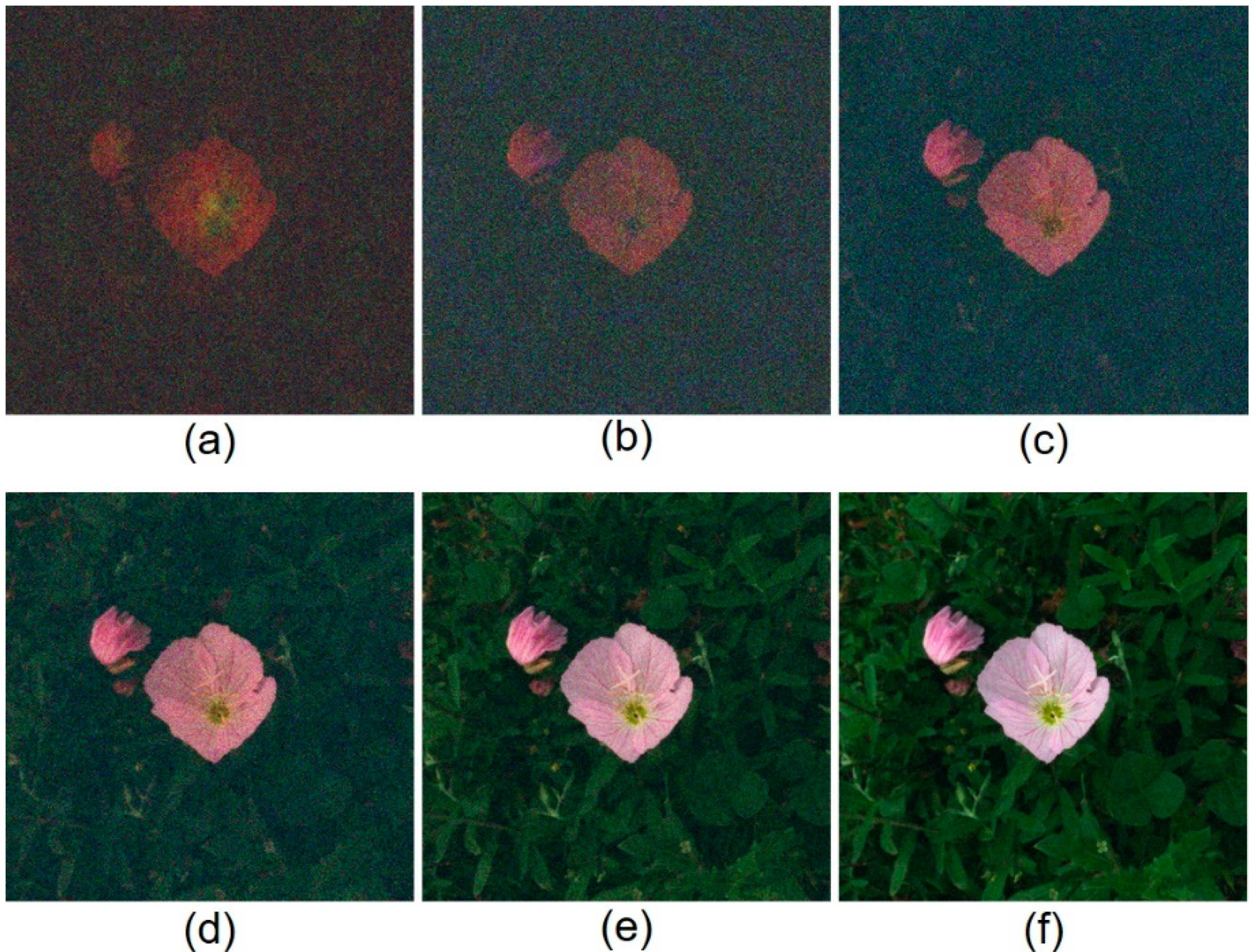
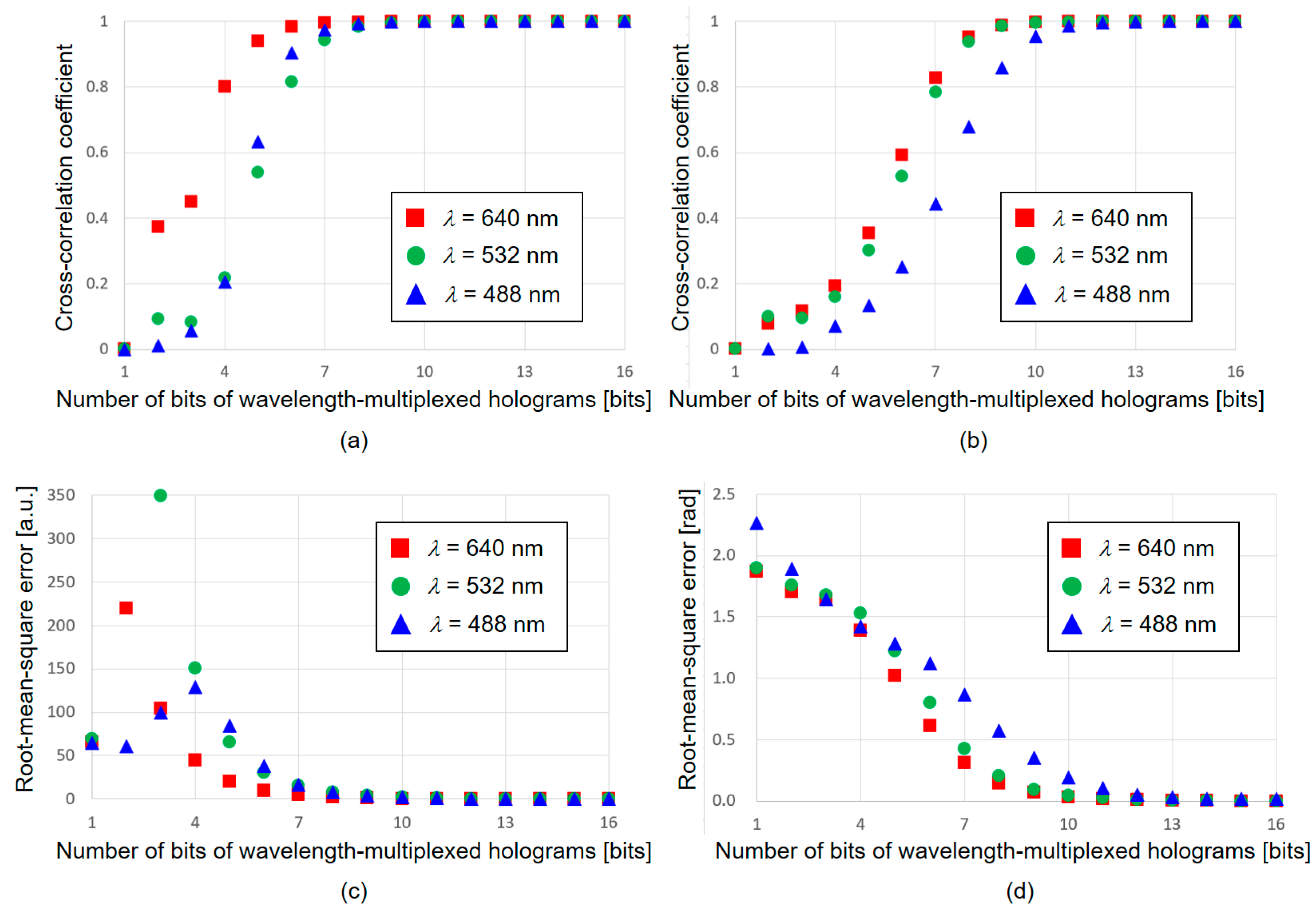
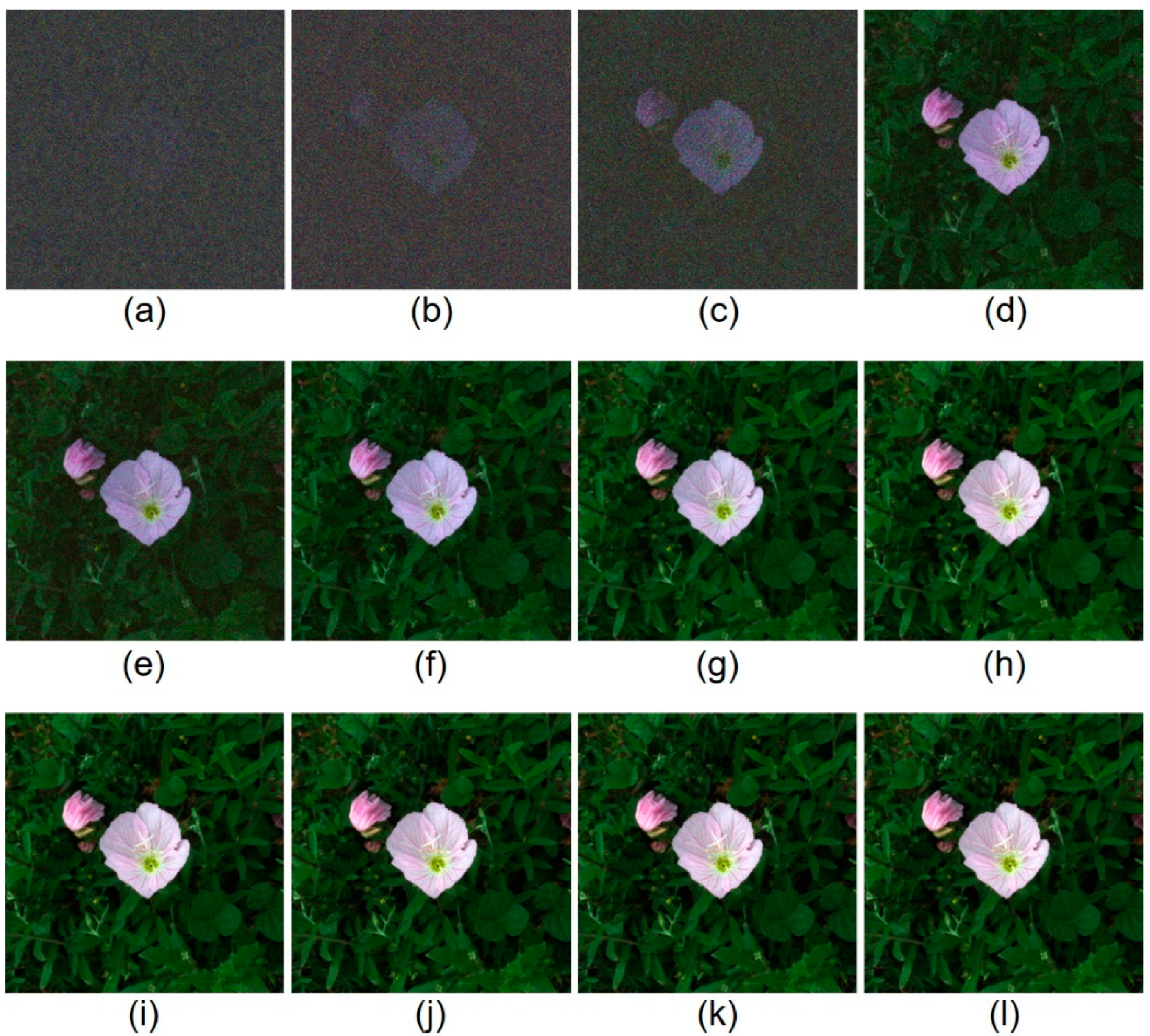
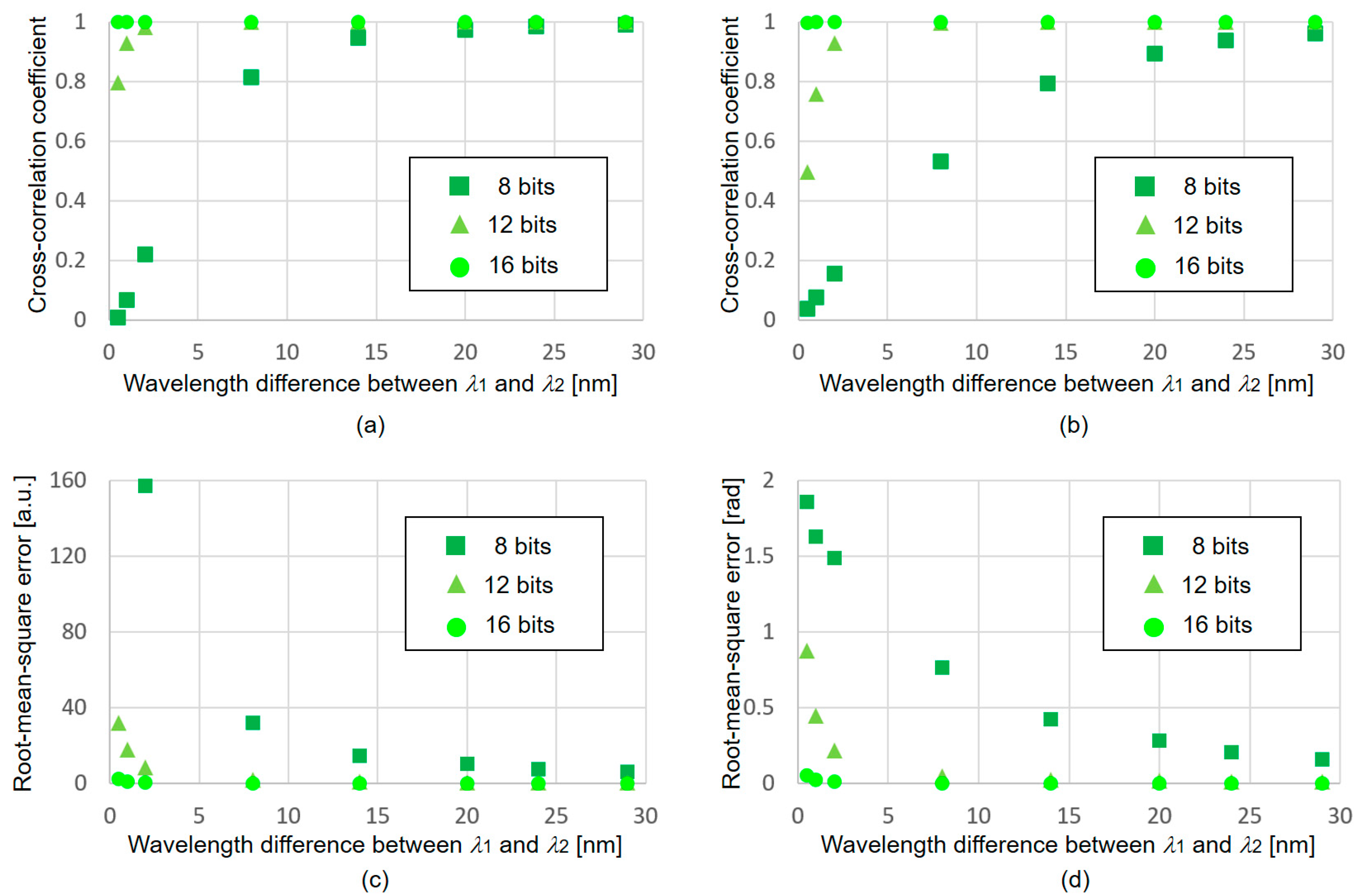
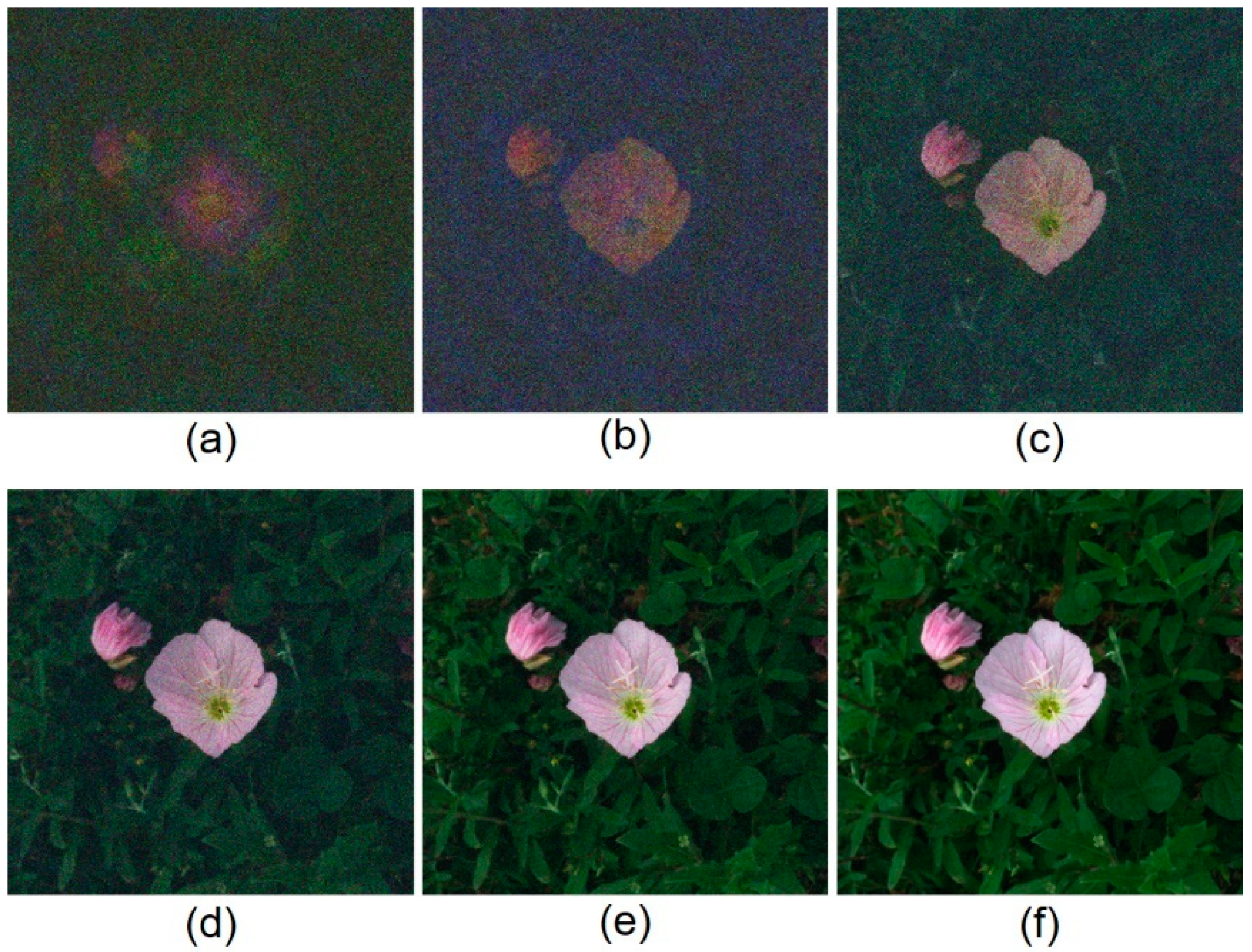
© 2018 by the authors. Licensee MDPI, Basel, Switzerland. This article is an open access article distributed under the terms and conditions of the Creative Commons Attribution (CC BY) license (http://creativecommons.org/licenses/by/4.0/).
Share and Cite
Tahara, T.; Otani, R.; Takaki, Y. Wavelength-Selective Phase-Shifting Digital Holography: Color Three-Dimensional Imaging Ability in Relation to Bit Depth of Wavelength-Multiplexed Holograms. Appl. Sci. 2018, 8, 2410. https://doi.org/10.3390/app8122410
Tahara T, Otani R, Takaki Y. Wavelength-Selective Phase-Shifting Digital Holography: Color Three-Dimensional Imaging Ability in Relation to Bit Depth of Wavelength-Multiplexed Holograms. Applied Sciences. 2018; 8(12):2410. https://doi.org/10.3390/app8122410
Chicago/Turabian StyleTahara, Tatsuki, Reo Otani, and Yasuhiro Takaki. 2018. "Wavelength-Selective Phase-Shifting Digital Holography: Color Three-Dimensional Imaging Ability in Relation to Bit Depth of Wavelength-Multiplexed Holograms" Applied Sciences 8, no. 12: 2410. https://doi.org/10.3390/app8122410
APA StyleTahara, T., Otani, R., & Takaki, Y. (2018). Wavelength-Selective Phase-Shifting Digital Holography: Color Three-Dimensional Imaging Ability in Relation to Bit Depth of Wavelength-Multiplexed Holograms. Applied Sciences, 8(12), 2410. https://doi.org/10.3390/app8122410



